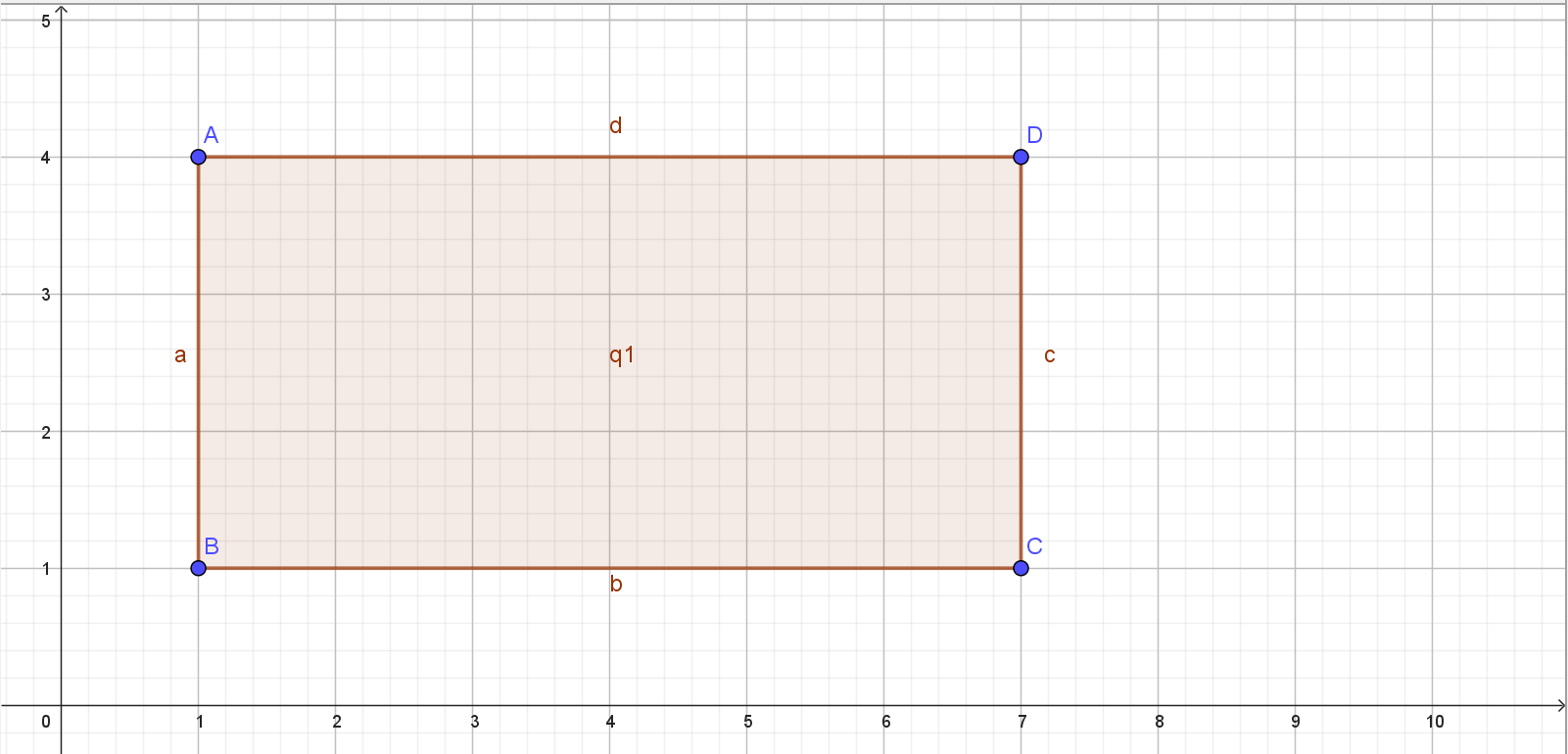扫描线思想与算法实现
给定平面直角坐标系内 \(n\) 个四边平行于坐标轴的矩形,求其面积并。第 \(i\) 个矩形的左下角和右上角分别为 \((x_{1,i},y_{1,i}),(x_{2,i},y_{2,i})\)。
扫描线思想
扫描线,顾名思义,就是模拟一条线在平面上扫来扫去,从而得出答案。
这一般用于图特别大以致于无法存储的情况。
如图,图中描绘的就是扫描线从下至上扫过的情况。当坐标系非常大以致于无法存储时,就可以运用扫描线,模拟一条线扫过值域,扫的同时统计答案即可。
扫描线算法
接下来讲解如何具体实现扫描线算法,以维护矩形面积并为例。其余信息都是类似的。
指针扫过一维
很简单,使用一个指针每次自增即可。不妨令其从左至右扫过。
我们需要知道的就是当前这一列内被覆盖的长度 \(\textit{len}_i\),答案即所有 \(\textit{len}_i\) 之和。
数据结构维护一维
维护纵轴上的区间信息,一般使用线段树。
具体而言,我们需要使用线段树维护纵区间内的值,有两种操作:
- 区间加 \(1\) 或区间减 \(1\),且加/减区间两两对应。(见下文)
- 求根节点维护区间内非 \(0\) 的数的个数。(如上文)
一般的线段树可能无法很好的维护此类信息,因为你并不知道减 \(1\) 之后有多少数会变成 \(0\)。
但是扫描线用到的线段树具有一个很强的性质:加/减区间两两对应。
那么也就是说,加操作与其对应的减操作在线段树上操作的的节点互相对应。
因此可以考虑对于每一个节点 \(i\),记 \(\textit{cover}_i\) 表示 \(i\) 对应区间被整体覆盖的次数,\(\textit{len}_i\) 为 \(i\) 对应区间内被覆盖的长度。
\(\textit{cover}_i\) 并不会下传,因为这样可以确保加/减操作时正确操作 \(\textit{cover}_i\),并且一一对应。
- 若 \(\textit{cover}_i>0\),则必有 \(\textit{len}_i\) 为对应区间长度。
- 否则,记 \(\textit{lChild}_i,\textit{rChild}_i\) 分别为 \(i\) 的左右子节点,有 \(\textit{len}_i=\textit{len}_{\textit{lChild}_i}+\textit{len}_{\textit{rChild}_i}\)。
这也是标记上传的逻辑。
为了便于表述,记矩形的左下角和右上角分别为 \((x_1,y_1),(x_2,y_2)\)。
根据上文的图,因为此处是从左至右扫过,因此可以:
- 扫到矩形的左边界 \(x_1\) 时将 \([y_1+1,y_2]\) 全部加上 \(1\),代表这一段都被矩形覆盖了。
- 扫到矩形的右边界 \(x_2\) 时将 \([y_1+1,y_2]\) 全部减去 \(1\),代表这一个矩形结束了,之后都不会被这个矩形覆盖(但是仍然可能被其他矩形覆盖)。
注意矩形对应区间不是 \([y_1,y_2]\),而是 \([y_1+1,y_2]\)。

如图,\(A(1,4),B(1,1)\),但是 \(AB=4-1=3\),对应第 \(2\sim 4\) 行。线段树维护的是第几行。(当然,你也可以说是 \(1\sim 3\) 行,对应上文 \([y_1+1,y_2]\) 改为 \([y_1,y_2-1]\),但是没有本质区别,相当于整体偏移。)
这里提供一份参考代码。
参考代码
但是这份代码无法通过例题的任意测试点,因为所有测试点的 $x,y$ 都是跑满 $10^9$ 的。数组会越界。
//#include<bits/stdc++.h>
#include<algorithm>
#include<iostream>
#include<cstring>
#include<iomanip>
#include<cstdio>
#include<string>
#include<vector>
#include<cmath>
#include<ctime>
#include<deque>
#include<queue>
#include<stack>
#include<list>
using namespace std;
typedef long long ll;
constexpr const int N=1e5,V=1e5;
struct line{
int l,r,w;
};
vector<line>q[N<<1|1];
struct segTree{
struct node{
int l,r;
int len,cover;
}t[N<<3|1];
int size(int p){
return t[p].r-t[p].l+1;
}
void up(int p){
if(t[p].cover){
t[p].len=size(p);
}else{
if(t[p].l==t[p].r){
t[p].len=0;
}else{
t[p].len=t[p<<1].len+t[p<<1|1].len;
}
}
}
void build(int p,int l,int r){
t[p]={l,r};
if(l==r){
t[p].cover=0;
t[p].len=0;
return;
}
int mid=l+r>>1;
build(p<<1,l,mid);
build(p<<1|1,mid+1,r);
up(p);
}
void add(int p,int l,int r,int k){
if(l<=t[p].l&&t[p].r<=r){
t[p].cover+=k;
up(p);
return;
}
if(l<=t[p<<1].r){
add(p<<1,l,r,k);
}
if(t[p<<1|1].l<=r){
add(p<<1|1,l,r,k);
}
up(p);
}
int query(){
return t[1].len;
}
}t;
int main(){
/*freopen("test.in","r",stdin);
freopen("test.out","w",stdout);*/
ios::sync_with_stdio(false);
cin.tie(0);cout.tie(0);
int n;
cin>>n;
static int x1[N+1],y1[N+1],x2[N+1],y2[N+1];
for(int i=1;i<=n;i++){
cin>>x1[i]>>y1[i]>>x2[i]>>y2[i];
}
for(int i=1;i<=n;i++){
q[x1[i]].push_back({y1[i],y2[i],1});
q[x2[i]].push_back({y1[i],y2[i],-1});
}
t.build(1,0,V);
ll ans=0;
for(int i=0;i<=V;i++){
for(auto x:q[i]){
t.add(1,x.l+1,x.r,x.w);
}
ans+=1ll*t.query();
}
cout<<ans<<'\n';
cout.flush();
/*fclose(stdin);
fclose(stdout);*/
return 0;
}
离散化
一般来讲,扫描线算法是需要离散化的。因为平面往往很大,超过 \(10^6\times10^6\) 时往往需要离散化。
当然,线段树维护的纵区间可以不离散化,动态开点权值线段树维护即可;但是这样第一常数更大,第二横区间本来就要离散化,纵区间也可以顺带离散化。
记 \(\operatorname{hashX}(x)\) 为排名为 \(x\) 的原来的有效 \(x\),\(\operatorname{hashY}(y)\) 同理。
此时线段树维护的区间 \([l,r]\) 便是排名在 \([l,r]\) 内的有效 \(y\)。其区间长度为 \(\operatorname{hashY}(r)-\operatorname{hashY}(l-1)\)。注意不是 \(\operatorname{hashY}(r)-\operatorname{hashY}(l)\)。
同时,指针扫到 \(i\) 时,这一整段相同的列的数量为 \(\operatorname{hashX}(i+1)-\operatorname{hash}(i)\)。
例题 AC 代码
//#include<bits/stdc++.h>
#include<algorithm>
#include<iostream>
#include<cstring>
#include<iomanip>
#include<cstdio>
#include<string>
#include<vector>
#include<cmath>
#include<ctime>
#include<deque>
#include<queue>
#include<stack>
#include<list>
using namespace std;
typedef long long ll;
constexpr const int N=1e5,V=1e5;
struct line{
int l,r,w;
};
vector<line>q[N<<1|1];
int hashX[N<<1|1],hashY[N<<1|1];
struct segTree{
struct node{
int l,r;
int len,cover;
}t[N<<3|1];
int size(int p){
return t[p].r-t[p].l+1;
}
void up(int p){
if(t[p].cover){
t[p].len=size(p);
}else{
if(t[p].l==t[p].r){
t[p].len=0;
}else{
t[p].len=t[p<<1].len+t[p<<1|1].len;
}
}
}
void build(int p,int l,int r){
t[p]={l,r};
if(l==r){
t[p].cover=0;
t[p].len=0;
return;
}
int mid=l+r>>1;
build(p<<1,l,mid);
build(p<<1|1,mid+1,r);
up(p);
}
void add(int p,int l,int r,int k){
if(l<=t[p].l&&t[p].r<=r){
t[p].cover+=k;
up(p);
return;
}
if(l<=t[p<<1].r){
add(p<<1,l,r,k);
}
if(t[p<<1|1].l<=r){
add(p<<1|1,l,r,k);
}
up(p);
}
int query(){
return t[1].len;
}
}t;
int main(){
/*freopen("test.in","r",stdin);
freopen("test.out","w",stdout);*/
ios::sync_with_stdio(false);
cin.tie(0);cout.tie(0);
int n;
cin>>n;
static int x1[N+1],y1[N+1],x2[N+1],y2[N+1];
for(int i=1;i<=n;i++){
cin>>x1[i]>>y1[i]>>x2[i]>>y2[i];
}
for(int i=1;i<=n;i++){
q[x1[i]].push_back({y1[i],y2[i],1});
q[x2[i]].push_back({y1[i],y2[i],-1});
}
t.build(1,0,V);
ll ans=0;
for(int i=0;i<V;i++){
for(auto x:q[i]){
t.add(1,x.l,x.r-1,x.w);
}
ans+=1ll*t.query();
}
cout<<ans<<'\n';
cout.flush();
/*fclose(stdin);
fclose(stdout);*/
return 0;
}



 浙公网安备 33010602011771号
浙公网安备 33010602011771号